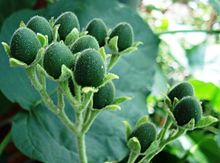Solanum abutiloides
| Solanum abutiloides | ||||||||||||
|---|---|---|---|---|---|---|---|---|---|---|---|---|

Solanum abutiloides - flowers and leaves |
||||||||||||
| Systematics | ||||||||||||
|
||||||||||||
| Scientific name | ||||||||||||
| Solanum abutiloides | ||||||||||||
| ( Griseb. ) Bitter & Lillo |
Solanum abutiloides (also "dwarf tree tomato ", "dwarf tamarillo " or "Brazilian velvet peach") ( syn .: Cyphomandra abutiloides ) is a plant species fromthe nightshade genus ( Solanum ) and isclassifiedin the Brevantherum section . It is occasionally cultivated for its small, egg-shaped, orange fruits .
description
Vegetative characteristics
Solanum abutiloides is a small, only 1 to 3 m high, non-reinforced shrub or tree . The young twigs are round, yellowish green and consistently soft-felted with star-shaped trichomes , which can be short or long-stalked and are glandular. The bark is yellowish-brown on older branches and the trunk .
The sympodial units have several leaves , ovoid to narrow ovoid axillary leaves are often formed in the axils. The leaves are simple, their leaf blade is ovate to broadly ovate, 7 to 27 cm long and 6 to 12 cm wide, membranous, strongly smelling and dark green in color. The top is pale green, velvety hairy, the trichomes are separated from each other until they overlap. The hair is composed of sessile and short-stalked, elongated, star-shaped, glandular trichomes with a particularly long middle arm. The underside is tomentose, the hairiness resembles that of the stem axis. Six to eight side veins are formed on each side of the midrib. The leaf base is heart-shaped, the leaf margin is entire, the tip is pointed. The leaf stalk is about 1/3 the length of the leaf blade and thus reaches lengths between 2 and 10 cm. It is covered with trichomes that are either short or long stalked.
Inflorescences and flowers
The inflorescences are 5 to 14 cm long, branched, woolly hairy, are pseudo-terminal and consist of 25 to 60 apparently hermaphrodite flowers . The inflorescence stalk is 8.3 to 12 cm long and 0.1 to 0.4 cm thick, the rachis is 0.5 to 2.5 cm long. The flower stalks are initially 3 to 6 mm long, but lengthen on the fruit to 5 to 16 cm. They are only 2 to 3.5 cm apart. Their base is slightly widened and articulated.
The buds have just before flowering mm, a length of 7 to 9, they are elongated to elliptical. The crown is hairy in the bud with glandular, sessile to short-stalked star-shaped trichomes. The connection seam between the sepals cannot be made out, the calyx separates early during the development of the bud. The calyx is almost bell-shaped when it blooms, 7 to 9.5 mm long, of which the calyx tube is 3 to 4 mm. The calyx lobes are 2/3 of the length to almost the base separated from each other and are lanceolate to half ovoid, almost leathery and 2.5 to 9.3 mm long and 2.2 to 5.5 mm wide. Their hair consists of star-shaped, mostly sessile, glandular trichomes. The calyx lobes enlarge slightly on the fruits and are then 6.5 to 10 mm long and 3.2 to 6 mm wide. The crown is white to bluish in color, has a diameter of 1.5 to 1.8 cm, is 8 to 10.5 mm long, star-shaped and is membranous, but appears thickened by thick hair. The corolla tube is 4 to 4.5 mm long. The corolla lobes are 4 to 7 mm long and 3 to 4.8 mm wide and oval-lanceolate in shape.
The stamens start about 1.7 to 1.9 mm above the base of the crown, they are 1.3 to 2 mm long and hairless. The anthers are yellow, 2.7 to 4.3 mm long, 1 to 1.6 mm wide, elongated and blunt-pointed. They stand free from each other and open through outwardly directed pores, which expand into longitudinal slits with age. The ovary is conical and tomentose with simple and star-shaped trichomes. The stylus stands out over the stamens, is 4 to 4.4 mm long and has a diameter of 0.2 to 0.4 mm. It is hairless or has a few star-shaped hairs in the lower half. The scar is heady.
Fruits and seeds
The fruits are fleshy, conical to spherical berries with a diameter of 1 to 1.1 cm, which are flattened at the tip. When ripe, they are yellow in color, but when they dry they turn dark brown. The permanent hair consists of sessile or short-stalked, simple or star-shaped trichomes.
The seeds are 1.2 to 1.5 mm long and 1 to 1.3 mm wide, triangular or almost circular, yellowish in color and provided with a reticulated-dotted surface.
Chromosome number
The number of chromosomes is 2n = 24.
Occurrence and locations
Solanum abutiloides is distributed along the Cordillera Central in Bolivia and on the eastern slopes of the Andes in Argentina . It grows there in thickets, on rocky or sandy river banks and open, disturbed areas. It can usually be found at higher altitudes between 900 and 3600 m.
Systematics and botanical history
The species was first described by August Grisebach as Cyphomandra abutiloides in 1879 . Georg Bitter classified the species in 1913 as the Solanum and there in the Anthoresis section . They put more recent works in the Solanum sect section . Brevant around a; In her monograph on the genus Cyphomandra (now listed as Solanum sect. Pachyphylla ), Lynn Bohs excludes the species from the genus due to the structure of trichomes and anthers.
swell
Individual evidence
- ↑ Solanum abutiloides at Tropicos.org. In: IPCN Chromosome Reports . Missouri Botanical Garden, St. Louis
- ↑ Lynn Bohs: Cyphomandra (Solanaceae) . In: Flora Neotropica , Volume 63, New York Botanical Garden, New York, USA, July 5, 1994. ISBN 0-89327-385-6 .
literature
- PBI Solanum: Solanum abutiloides , online, accessed May 22, 2009.
Web links
- Solanum abutiloides , description at delta-intkey.com

